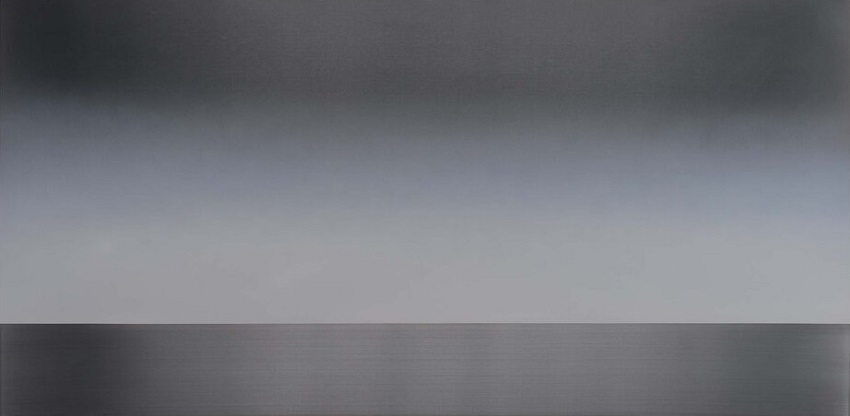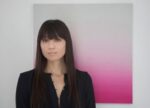David Lynch Foundation Video Interview (6:27)
In this video, Miya Ando speaks about the source of her creativity, her creative process, her aesthetics and her view of the world. It offers us a deeper understanding of the artist, her work and her appeal.

Miya Ando
American, 1973-
Hamon 2.4.2, 2015
pigment and urethane on aluminum
24 x 48 in.
SBMA, Gift of Edith Caldwell and Miya Ando
2020.3.3

Miya Ando - Outside Looking In, 2014, Lesley Kehoe Galleries
“In my work, I create quiet, abstract, meditative environments with metal. Ultimately I am interested in the study of subtraction to the point of purity, simplicity and refinement.” - Miya Ando
RESEARCH PAPER
Miya Ando is a contemporary artist whose works encourage serenity and
contemplation. Her art captures the harmony in disparate things, integrating
tradition and modernity, organic and fabricated, durable and transitory, East and
West.
Born in Los Angeles to a Japanese mother and a Russian-American father, Ando is
herself a blend of diverse influences. During childhood, her time was split between
a home among the redwoods of northern California and a Nichiren Buddhist temple
in Okayama, Japan, where her grandfather was the head priest. She holds a
bachelor's degree in East Asian Studies from UC Berkeley, and in 1998 apprenticed
with a master metalsmith in Japan. She works out of a studio in Long Island City,
New York, and lives with her artist husband in the Chelsea neighborhood of
Manhattan.
Ando's primary medium is metal. Her fascination with steel, aluminum, and other
alloys stems in part from her ancestral lineage of Japanese swordmakers from Bizen
Province (now Okayama) on the island of Honshu, a region famous for its
metalwork and pottery. Her father was an auto hobbyist who sanded and welded
car parts, inspiring her love for metallurgy and automotive finishing. Moreover,
living for many years in industrialized cities like San Francisco and New York has
provided her an appreciation for the beauty and possibilities of metal. Rather than
reproducing the flat, predictable hues one might expect from the medium, Ando
creates pieces reminiscent of abstract landscapes bathed in ethereal light. Through
painstaking processes involving anodizing, electrochemical baths, and meticulous
sanding, Ando coaxes forth breathtaking color gradients and subtle textures that
mimic the ever-shifting shades of water, sky and clouds.
It might seem inharmonious for artworks meant to promote stillness and
contemplation to be associated with deadly weaponry, but there is a profound bond.
To be steady warriors, samurai needed "heijoshin", which means having presence of
mind, calmness under duress, and ceaseless psychic tranquility. Thus, the mental
state required of a warrior is precisely the state of mind that Ando's works are
intended to evoke.
Ando often uses the term "mujō" in reference to her art. Mujō is a Japanese word
originating in Buddhism, and means impermanence or mutability. Ando skillfully
combines the hardiness of metal with themes of transience. "There's beauty in
recognizing that all things are transitory," Ando says. Her medium is durable,
whereas her images feel evanescent, an interplay of contrasts.
Her daily meditation practice is essential to her art, a creative tool as important as
brushes, pigments or dyes. These peaceful, contemplative works emerge from
mental quietude and focused calm. The result is art that is deeply philosophical,
inviting viewers into a state of equanimity. They are invited to slow down, to lose
themselves in the subtleties of texture and color, and to contemplate the integration
of opposites.
Ando's reach extends beyond metal. She works with wood, glass and paper, each
medium expressing a different facet of her artistic voice. Her installations, often
incorporating found objects and natural elements, create immersive experiences
that blur the lines between art and environment.
Hamon 2.4.2 is a quintessential example of Ando's art. Using brushes, she has
applied a handmade paint of pigment and urethane in multiple, thin layers onto the
metal canvas. The canvas is divided into two sections, one above the other. The
bottom fifth is a bold silver band in which delicate horizontal brush strokes are
visible. The top area is a gentle mist of color, transitioning gradually from a creamy
white at the bottom to a metallic indigo in the middle to a dark gray at the top.
Having two such horizontal bands is a convention that Ando uses in many works
contemporary with Hamon 2.4.2. She's working in a place between abstraction and
landscape, and to some these works suggest seascapes abstracted to the point of
featurelessness. Her perfectionism and artistic integrity produce art that feels
flawless and uncluttered, with a minimalist aesthetic that expresses only essentials.
Ando's choice to render the bottom band in silver (perhaps the least organic color)
departs from other similar works where she renders the bottom band in blue or
green. Here she brazenly embraces her medium. It's helpful to keep the title in
mind, and to remember that Ando is a descendant of swordmakers. "Hamon" is a
Japanese term that refers to a cloud-like pattern along the edge of a sword. Given
her choice of silver at the base and a soft, cloudy effect above, the connection to
swordmaking is palpable. Ando gives water and sky the character of a blade,
merging the natural and the manufactured. Hamon 2.4.2 is nature polished and
purified.
2.4.2 refers to the dimensions of the piece (2′ × 4′) and its position as second in a
series.
Prepared for the Santa Barbara Museum of Art Docent Council by Michael Wilk,
2024.
BIBLIOGRAPHY
Ando, Miya. "Introduction"; Miya Ando's Website, n.d.
https://www.miyaando.com/introduction
Cutruzzula, Kara. "Artist Miya Ando" Alchemy on Display at Sundaram Tagore
Gallery." Newsweek, 20 June 2013.
https://www.newsweek.com/2013/06/19/artist-miya-andos-alchemy-display-
sundaram-tagore-gallery-237606.html
Dolle, Coco. "Meeting Miya Ando ;My Art Is a Response to the Zeitgeist."; Whitehot
Magazine, January 2023.
https://whitehotmagazine.com/articles/art-is-response-zeitgeist-/5665
Kuzui, Fran. "Artist Miya Ando Builds Silent Bridges." Nikkei Asia, 9 March 2017.
https://asia.nikkei.com/NAR/Articles/Artist-Miya-Ando-builds-silent-bridges
Speer, Richard. "Xanax for the Eyes, Zen for the Soul". Nancy Toomey Fine Art
Website, 28 August 2020.
https://nancytoomeyfineart.com/news/richard-speer-review-miya-ando-exhibition-
equanimity-meditations
Thorne, James. "Studio Visit: Miya Ando". Cool Hunting Website, 18 July 2012.
https://coolhunting.com/culture/studio-visit-miya-ando
"5 Things We Learned... Miya Ando". Culture A Website, 13 December 2018.
https://www.culture-a.com/5things/miya-ando
"Explore Past Miya Ando Projects". Nancy Toomey Fine Art Website, 1 October
2020.
https://nancytoomeyfineart.com/news/explore-past-miya-ando-projects
"Hamon". Wikipedia, Wikimedia Foundation, last modified 9 December 2023.
https://en.wikipedia.org/wiki/Hamon_(swordsmithing)
"Light Metal: About This Exhibition". Sundaram Tagore Website, 16 January 2014.
https://www.sundaramtagore.com/exhibitions/miya-ando2
"Miya Ando". Wikipedia, Wikimedia Foundation, last modified 17 December 2023.
https://en.wikipedia.org/wiki/Miya_Ando
"Miya Ando's Industrial Watercolors". Chapman University Website, 21 August 2015.
https://blogs.chapman.edu/collections/2015/08/21/miya-andos-industrial-
watercolors
"Sora/Ku: About This Exhibition". Sundaram Tagore Website, 5 September 2015.
https://www.sundaramtagore.com/exhibitions/miya-ando5/selected-works
COMMENTS
Lora Schlesinger Gallery presents Hamon (Cloud-like Pattern), a new series of ephemeral and luminous abstract paintings and works on paper by New York artist MIYA ANDO. A descendant of Bizen sword makers turned Buddhist priests, Miya combines traditional techniques of her ancestry with contemporary industrial technology, transforming metal into ethereal abstract paintings.
Miya Ando uses aluminum plates as blank canvases to create quiet minimal meditative environments that transcend the physical properties of metal, into metaphysical landscapes. Her work is an exploration of the duality of metal and the fleetingness of light. Miya Ando’s new series of white paintings and related drawings extends her interest in creating a body of work that investigates multiple levels of temporality and impermanence. In the process of Japanese sword-making, a cloud-like pattern is created as a result of hardening steel, called ‘Hamon’. Though a cloud appears solid it is temporal and constantly changing while suspended in atmosphere. Her interests in transference and extending traditional notions of process onto contemporary objects, explores how light can change materials. Using a signature daily layering technique of dye, pigment, lacquer and resin on aluminum plates, she creates gradations of color that interplay with the reflection of light. The resulting shifts in color resemble abstracted metallic horizons, reflective of the transitory nature of all things in life.
Miya Ando has exhibited nationally and internationally including solo exhibitions in galleries throughout Los Angeles, New York, Seattle, and Tokyo. She recently completed two 9/11 Memorial Sculptures from pieces of steel from the World Trade Center for the cities London, England and Santa Cruz, California. Miya’s public commissions include projects in Puerto Rico, South Korea, London, New York and California. Her work can be found in the collections of the Aldrich Contemporary Museum in Connecticut, The New House Center for Contemporary Art in New York, The Byzantine Museum in Greece and the Chapman University Collection in California. She is the recipient of the Pollock-Krasner award in 2012, a Gilbert Slomowitz Foundation Grant in 2011, a Thanatopolis Special Artist Award and Public Outdoor Commission Winner and a Puffin Foundation Grant winner in 2010. She received her Bachelor of Science Magna Cum Laude in East Asian Studies at UC Berkeley and continued her studies at Yale in 1998 in addition to an apprenticeship in 1999 to a master metal smith in Japan.
- Maya Ando’s Hamon, Lora Schlesinger Gallery, 2014
https://vdocuments.net/miya-andos-hamon-cloud-like-pattern.html?page=3
Nature serves as form and metaphor for expressing the concepts of impermanence and interdependence in Miya Ando’s artworks. The artist’s paintings, sculptures, drawings, and installations are a physical articulation of Ando’s contemplation of the cycles of nature and the inexorable passage of time. Concept, image, and materials are inextricably linked in the artist’s work. Ando transforms her mindfully chosen substrates: steel, wood, glass, aluminum – materials symbolizing permanence -- to offer a view of that which is transitory. The layered, refractive surfaces of Ando’s sculptures and experiential paintings on metal, mirror the ephemeral nature of their subject, which is often fleeting natural phenomena: the seasons, light, clouds, tides evoked in the artist’s minimal visual syntax. Likewise, indigo drawings on washi paper represent a glimpse of the momentary – a glint of moonlight on a wave, or the radiant of a meteor shower. Juxtaposing the manmade with the organic, the material with the immaterial, polarity and harmony coexist in the artist's work. This polarity is rooted in Ando’s unique perspective as an artist occupying a vantage point between Japanese and Western culture. Language, a signifier of cultural values, is integral to the artist’s creative inquiry. Undertaking extensive research of Japanese literature and historical texts for the past two decades, Ando records and translates historic, mostly arcane Japanese words that express a philosophy of existence and a relationship to nature which she seeks to preserve and translate into visual form through her art. The poetic, multilayered Japanese words Ando uncovers describe the moon, rain, clouds, and other elements. They demonstrate an immense reverence for the ephemeral natural world and an acute awareness of one's dependence upon it. Conveying sentiments not found in Western thought, Ando provides an approximate English translation of these words in the titles for her artworks, consciously revealing the gap between the two languages and cultures that have informed her identity and point of view.
https://www.miyaando.com/introduction
SBMA CURATORIAL LABELS
Miya Ando is a New York-based visual artist of Japanese and Russian descent. She is a sixteenth-generation descendant of Ando Yoshiro Masakatsu, a famous Bizen sword maker. She was raised among sword smiths-turned-Buddhists in a Buddhist temple in Okayama, Japan. While using the material of aluminum, Ando draws upon her family’s heritage of working with steel to create this work. Hamon refers to the visual effect, particularly the wavy pattern, created on a sword’s steel blade during the hardening process that was traditionally used to judge its artistic value. By layering tinted polyurethane varnish on polished aluminum, Ando creates a light-suffused surface that is at once reflective, temporal, and transitory, seminal to the qualities of subtle transformation one experiences in nature.
- Asian Art Reopening, 2021
